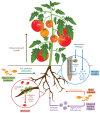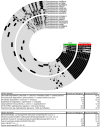Friends and Foes: Bacteria of the Hydroponic Plant Microbiome
- PMID: 39519984
- PMCID: PMC11548230
- DOI: 10.3390/plants13213069
Friends and Foes: Bacteria of the Hydroponic Plant Microbiome
Abstract
Hydroponic greenhouses and vertical farms provide an alternative crop production strategy in regions that experience low temperatures, suboptimal sunlight, or inadequate soil quality. However, hydroponic systems are soilless and, therefore, have vastly different bacterial microbiota than plants grown in soil. This review highlights some of the most prevalent plant growth-promoting bacteria (PGPB) and destructive phytopathogenic bacteria that dominate hydroponic systems. A complete understanding of which bacteria increase hydroponic crop yields and ways to mitigate crop loss from disease are critical to advancing microbiome research. The section focussing on plant growth-promoting bacteria highlights putative biological pathways for growth promotion and evidence of increased crop productivity in hydroponic systems by these organisms. Seven genera are examined in detail, including Pseudomonas, Bacillus, Azospirillum, Azotobacter, Rhizobium, Paenibacillus, and Paraburkholderia. In contrast, the review of hydroponic phytopathogens explores the mechanisms of disease, studies of disease incidence in greenhouse crops, and disease control strategies. Economically relevant diseases caused by Xanthomonas, Erwinia, Agrobacterium, Ralstonia, Clavibacter, Pectobacterium, and Pseudomonas are discussed. The conditions that make Pseudomonas both a friend and a foe, depending on the species, environment, and gene expression, provide insights into the complexity of plant-bacterial interactions. By amalgamating information on both beneficial and pathogenic bacteria in hydroponics, researchers and greenhouse growers can be better informed on how bacteria impact modern crop production systems.
Keywords: food production; greenhouses; hydroponics; plant growth-promoting bacteria; plant pathogens; plant stress.
Conflict of interest statement
H.C.R., A.A.S., and B.R.J. are employed by Ceragen Inc., a company that develops probiotics for hydroponic growers.
Figures


Similar articles
-
Assessing the comparative effects of interventions in COPD: a tutorial on network meta-analysis for clinicians.Respir Res. 2024 Dec 21;25(1):438. doi: 10.1186/s12931-024-03056-x. Respir Res. 2024. PMID: 39709425 Free PMC article. Review.
-
Behavioral interventions to reduce risk for sexual transmission of HIV among men who have sex with men.Cochrane Database Syst Rev. 2008 Jul 16;(3):CD001230. doi: 10.1002/14651858.CD001230.pub2. Cochrane Database Syst Rev. 2008. PMID: 18646068
-
Phylogenetic analysis of plant-pathogenic and non-pathogenic Trichoderma isolates on maize from plants, soil, and commercial bio-products.Appl Environ Microbiol. 2025 Mar 19;91(3):e0193124. doi: 10.1128/aem.01931-24. Epub 2025 Feb 27. Appl Environ Microbiol. 2025. PMID: 40013788 Free PMC article.
-
A rapid and systematic review of the clinical effectiveness and cost-effectiveness of paclitaxel, docetaxel, gemcitabine and vinorelbine in non-small-cell lung cancer.Health Technol Assess. 2001;5(32):1-195. doi: 10.3310/hta5320. Health Technol Assess. 2001. PMID: 12065068
-
A rapid and systematic review of the clinical effectiveness and cost-effectiveness of topotecan for ovarian cancer.Health Technol Assess. 2001;5(28):1-110. doi: 10.3310/hta5280. Health Technol Assess. 2001. PMID: 11701100
Cited by
-
The Good, the Bad, and the Fungus: Insights into the Relationship Between Plants, Fungi, and Oomycetes in Hydroponics.Biology (Basel). 2024 Dec 4;13(12):1014. doi: 10.3390/biology13121014. Biology (Basel). 2024. PMID: 39765681 Free PMC article. Review.
-
The Microbiome Characterization of Edible Visceral Organs and Fresh Meat During Production in a Pig Processing Facility in Thailand.Pathogens. 2025 May 14;14(5):475. doi: 10.3390/pathogens14050475. Pathogens. 2025. PMID: 40430796 Free PMC article.
-
Endophytes in Cannabis sativa: Identifying and Characterizing Microbes with Beneficial and Detrimental Effects on Plant Health.Plants (Basel). 2025 Apr 19;14(8):1247. doi: 10.3390/plants14081247. Plants (Basel). 2025. PMID: 40284136 Free PMC article. Review.
-
The PGPB paradox: A critical review of field performance and practical constraints in agriculture.World J Microbiol Biotechnol. 2025 Sep 8;41(9):321. doi: 10.1007/s11274-025-04552-y. World J Microbiol Biotechnol. 2025. PMID: 40924218 Review.
-
Bacillus megaterium GXU087 secretes indole - 3 - lactic acid to promote soybean growth and nodulation.Front Plant Sci. 2025 Mar 21;16:1560346. doi: 10.3389/fpls.2025.1560346. eCollection 2025. Front Plant Sci. 2025. PMID: 40190661 Free PMC article.
References
-
- Velazquez-Gonzalez R.S., Garcia-Garcia A.L., Ventura-Zapata E., Barceinas-Sanchez J.D.O., Sosa-Savedra J.C. A Review on Hydroponics and the Technologies Associated for Medium- and Small-Scale Operations. Agriculture. 2022;12:646. doi: 10.3390/agriculture12050646. - DOI
-
- Gowdy J. Our Hunter-Gatherer Future: Climate Change, Agriculture and Uncivilization. Futures. 2020;115:102488. doi: 10.1016/j.futures.2019.102488. - DOI
-
- Can We Ditch Intensive Farming—And Still Feed the Human Race? | Global Soil Partnership | Food and Agriculture Organization of the United Nations. [(accessed on 6 September 2024)]. Available online: https://www.fao.org/global-soil-partnership/resources/highlights/detail/...
-
- Nemali K. History of Controlled Environment Horticulture: Greenhouses. HortScience. 2022;57:239–246. doi: 10.21273/HORTSCI16160-21. - DOI
-
- Farvardin M., Taki M., Gorjian S., Shabani E., Sosa-Savedra J.C. Assessing the Physical and Environmental Aspects of Greenhouse Cultivation: A Comprehensive Review of Conventional and Hydroponic Methods. Sustainability. 2024;16:1273. doi: 10.3390/su16031273. - DOI
Publication types
LinkOut - more resources
Full Text Sources

